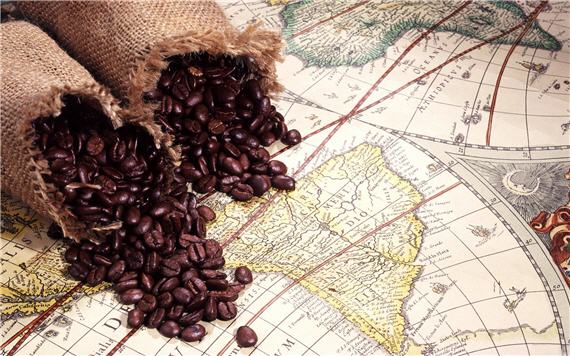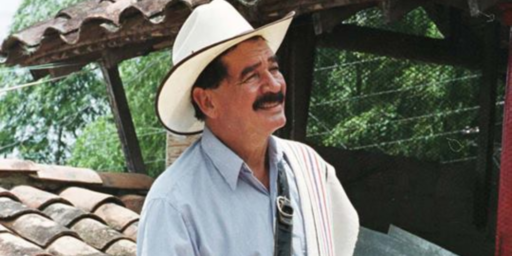Peak Coffee?
We've been hearing about peak oil for years. But now some experts are warning of an even more serious crisis: Peak coffee.

We’ve been hearing about peak oil for years. But now some experts are warning of an even more serious crisis: Peak coffee.
NYT (“Coffee, the New Shaky Commodity“):
Coffee prices are going up and up, as fast-rising demand in China and India puts pressure on the world’s growers to increase their supplies. But, as detailed in a Times article by Elisabeth Rosenthal, farmers in a prime growing region of Colombia are finding that more intense rainstorms and warmer temperatures are making it harder to produce enough Arabica, the high-grade shade-grown varietal prized by those societies that can afford it.
While “peak coffee” may not be the same as peak oil, coffee is a commodity like no other. How will the heated market affect the ever evolving culture of coffee connoisseurship? What does history tell us about the role of coffee in unifying communities and advancing civilization, let alone in keeping everyone awake?
NYT (“Heat Damages Colombia Coffee, Raising Prices“):
[I]n the last few years, coffee yields have plummeted here and in many of Latin America’s other premier coffee regions as a result of rising temperatures and more intense and unpredictable rains, phenomena that many scientists link partly to global warming.
Coffee plants require the right mix of temperature, rainfall and spells of dryness for beans to ripen properly and maintain their taste. Coffee pests thrive in the warmer, wetter weather.
[…]
In 2006, Colombia produced more than 12 million 132-pound bags of coffee, and set a goal of 17 million for 2014. Last year the yield was nine million bags.
Brands like Maxwell, Yuban and Folgers have increased the retail prices of many grinds by 25 percent or more since the middle of last year in light of tight supply and higher wholesale prices.
Profits of high-end coffee chains like Starbucks and Green Mountain have been eroded. Coffee futures of Arabica, the high-end bean that comes predominantly from Latin America, have risen more than 85 percent since last June, to $2.95 a pound, partly over concerns about supply, extreme weather and future quality, said George Kopp, an analyst at the International Futures Group in Chicago.
Yet as stockpiles of some of the best coffee beans shrink, global demand is soaring as the rising middle classes of emerging economies like Brazil, India and China develop the coffee habit.
“Coffee production is under threat from global warming, and the outlook for Arabica in particular is not good,” said Peter Baker, a coffee specialist with CABI, a research group in Britain that focuses on agriculture and the environment, noting that climate changes, including heavy rains and droughts, have harmed crops across many parts of Central and South America. A top coffee scientist, he has rattled trade forums by warning, Cassandra-like, of the possibility of “peak coffee,” meaning that, like oil supplies, coffee supplies might be headed for an inexorable decline unless growers make more concerted efforts to expand production globally.
The Specialty Coffee Association of America warned this year, “It is not too far-fetched to begin questioning the very existence of specialty coffee.”
FT (“Arabica coffee at 34-year peak“):
Arabica coffee prices rose to a 34-year high – fast-approaching the barrier of $3 per pound – amid a long-standing shortage of the high-quality bean appreciated by espresso connoisseurs.
[…]
Coffee traders believe that Arabica prices will soon break past $3.40 a pound, forcing roasters to raise retail prices once more. The wholesale price of Arabica coffee has jumped nearly 125 per cent during the past year.
A series of retail price rises has not so far dented consumption growth, industry executives said.
JM Smucker , the US company behind the Folgers coffee brand that is seen as the trendsetter in the sector, has raised retail prices three times during the past year and has warned it would do so again if wholesale prices were not to fall soon. But the ICO said in its monthly report: “The precarious balance between supply and demand continues to favour firm prices.”
A September report from Consumer Energy Report (“Have We Hit Peak Coffee?“) blamed the phenomenon on demand rather than weather.
The world will soon hit “Peak Coffee,” with some commentators saying it has already been reached. Analysts point to fast rising demand from China and India as the culprit for the current strain on world markets.
The International Coffee Organization (not to be confused with OCEC — the Organization of Coffee Exporting Countries), dominated by Brazil (the “Brazil” of coffee), Colombia and Costa Rica, moved to assure world markets that they had plenty of “spare capacity,” and that coffee was trading in an “acceptable” price range. This has done little to allay fears around the world that Peak Coffee and subsequent high prices will lead to a shortage and plunge the world into a coffee deprived depression.
[…]
Part of the blame is widely laid at the feet of the “Big Three”: Starbucks, Peets, and Tim Hortons, who, over the last two decades have produced ever larger “pick up coffees” and luxury SUB’s (Sexy Urban Blends, like caramel macchiatos), instead of making small, efficient, European style coffees. Even the imported Espresso gets super sized and relabeled the “Americano” for the US market.
Under government pressure, the Big Three have committed to doing research on “hybrid” and “eclectic” coffees, but many see this as them just paying lip service while they continue to sell grande sized caramel macchiatos. Others point to the widespread use of diesel coffee in Europe, which dramatically reduces coffee consumption, but the Big Three have steadfastly refused to introduce it here. Despite being the darlings of the west coast treehuggers and movie stars, hybrid coffees are yet to catch on, and eclectics, which don’t use any coffee at all, are an unknown quantity in the market – it is feared that customers will suffer “caffeine anxiety” and not buy them.
I presume the last of these is satirical.






Count me as skeptical that you can have “peak” anything that is not a diminishing resource. If I can’t get a cup of joe someday, it won’t be because coffee production has peaked, it will be because consumer taste and government policy have created a different set of critiria for land use.
PD: I gather the issue here is twofold. First, climate change has made it harder to grow coffee. Second, affluence in China and India have driven up demand for coffee.
As conservatives, shouldn’t we be drinking tea? I mean. c’mon.
Wouldn’t drinking the tea be the opposite of what the tea party’s namesake did?
The moment I saw the title I knew global warming had to be in there somewhere.
I hear global warming has increased the price of gold, oil, corn and copper, too.
Its just as wicked as it seems.
Climate change as a long-term limiting factor is unlikely. Coffee has always grown in widely distributed farms on all continents. If there were a regional climate change, the optimal growing region would more likely shift than disappear.
Now, it’s possible but unlikely that a favorable climate could disappear from beneath a popular growing region. It would take a while then for farms to move and reestablish.
(Why did Starbucks have to open in China?)
“As conservatives, shouldn’t we be drinking tea?”
Chicory?
Check out production rates of Chocolate. The changeover in Africa on cacao plantations from what was essentially child slave labor to paying farms has made cacao often to expensive to farm. Apparently people don’t want to get paid to do backbreaking manual labor on the equator, no matter how good the pay is.
Chocolate prices are set to rise dramatically in the next 10 years. From what I understand, the only way to really avoid this (besides farming more–see above) is to cut the chocolate by reducing the amount of cocoa butter in it and replacing it with types of vegetable oil.
Hershey’s did just that, and the FDA ruled that it couldn’t be called chocolate. Now no chocolate producer wants to follow suit.
Of course this isn’t “peak chocolate” in that the reasons behind the diminishing production is controllable. Its still scary for us Reese”s lovers.
First, climate change has made it harder to grow coffee.
Don’t those Columbians know it’s all a hoax?
John,
You do realize that global warming means all regions are experiencing climate change, right? Not one or two or some. All.
Ben, coffee grows at altitude and near the equator.
What happens when all regions experience climates change? Do the micro-climates that were found at altitude and near the equator disappear from the earth?
(The answer is that they move. One of the most common scientific concerns is that they move too fast for plant and animal communities to move with them, resulting in loss of biodiversity. If one mountain range is good for fern, and the optimal climate for that fern shifts to the next mountain range to the north, the fern may die. Now think about cultivation, and review my comments above. I assume that coffee growers can move.)